Butterflies and Moths
Media

Species Types
Scientific Name
Phoebis sennae
Description
The cloudless sulphur is the large, clear-yellow butterfly you see flying rapidly to the southward in late summer and fall: They’re migrating!
Media
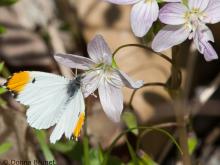
Species Types
Scientific Name
Anthocharis midea
Description
Falcate orangetip males are unmistakable with their small size, white coloration, and orange wingtips. Look for them in open woodlands in April.
Media
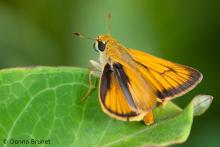
Species Types
Scientific Name
Anatrytone logan
Description
The undersides of the Delaware skipper's wings are solid orange. It's found statewide in a variety of habitats.
Media
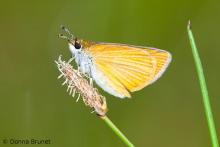
Species Types
Scientific Name
Ancyloxypha numitor
Description
One of the smallest skippers in the eastern United States, the least skipper is found in moist, grassy areas, usually near water.
Media

Species Types
Scientific Name
Polites peckius
Description
Peck’s skipper is found in Missouri’s fields, lawns, and other open habitats from May through October. Identify it by the one yellow hindwing rectangle that is wider than the others.
Media

Species Types
Scientific Name
Pyrgus communis
Description
The white and black checkered pattern makes this a simple identification. The common checkered skipper is the only checkered skipper in Missouri.
Media
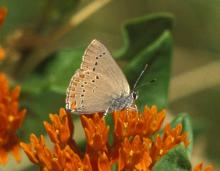
Species Types
Scientific Name
Satyrium titus (syn. Harkenclenus titus)
Description
The coral hairstreak is the only Missouri hairstreak lacking hindwing “tails” and without a blue spot on the outer hindwing edge.
Media

Species Types
Scientific Name
Celastrina ladon
Description
The spring azure is among the first butterflies of the year. It occurs in a variety of habitats. The early spring appearance helps you identify it.
Media
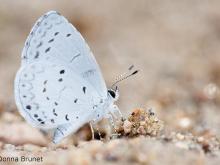
Species Types
Scientific Name
Celastrina neglecta
Description
Formerly considered the same species as the spring azure, the summer azure can be identified, in large part, by the season when you see it.
Media

Species Types
Scientific Name
Libytheana carinent
Description
Most of us identify butterflies by their color patterns, but you can ID the American snout by its long “nose.”
See Also


Media

Species Types
Scientific Name
About 1,500 species in North America north of Mexico
Description
Adult caddisflies are mothlike. Their larvae are aquatic and build portable, protective cases out of local materials, including grains of sand, bits of leaves and twigs, and other debris.
Media

Species Types
Scientific Name
Corydalus cornutus
Description
Adult eastern dobsonflies are huge and mothlike, with large wings and a weak, fluttery flight. The fiercely predaceous aquatic larvae, called hellgrammites, are well-known to anglers, who often use them as bait.
About Butterflies and Moths in Missouri
Butterflies, skippers, and moths belong to an insect order called the Lepidoptera — the "scale-winged" insects. These living jewels have tiny, overlapping scales that cover their wings like shingles. The scales, whether muted or colorful, seem dusty if they rub off on your fingers. Many butterflies and moths are associated with particular types of food plants, which their caterpillars must eat in order to survive.





















